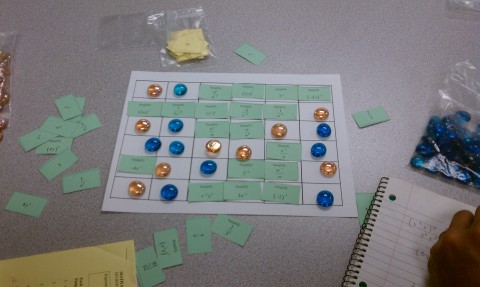A few weeks ago I built two new games for algebra in one week. These games just use the game mechanic from “Antiderivative Block” (a Calculus game), but with algebra-oriented game cards. The game mechanic is a classic “get 4-in-a-row” so it’s pretty easy to learn.

Exponent Block (plus Gameboard) will help students contrast slightly different expressions involving exponent rules, especially negative and zero exponents.
Factor Pair Block (plus Gameboard) will help prepare students for a unit on factoring. There are two sets of playing cards (print each set on a different color of paper if you want to be able to easily separate them). The first set of cards works with factor pairs for natural numbers and finding the GCF for two numbers. The second set of cards helps students start to see the GCF for monomials.
Supplies: I have found that it’s worth the investment in some bags of “marble markers” to play these (and other) games. These can generally be found at a store like Hobby Lobby or JoAnn’s Fabric. I’ve included markers that you can cut out and use, but trust me, that’s a pain. It is also very helpful to print the game cards (two-sided) on cardstock, so if you don’t have a ready supply of cardstock in multiple colors, I’d pick some of those up too. Last, small plastic bags are going to be a necessity to hold the sets of cards.

It’s interesting to watch the students play these games. Many students who seem to be uninterested in learning the fine differences between expressions in normal circumstances land in deep explanations of why these expressions simplify differently when playing the game.
Expect that students will play two ways. Some will play the intended game mechanic, playing competitively to get four-in-a-row. Other groups will play to “fill the board” … frankly, I can’t see what’s fun about this, but it never fails that at least two pairs of students do this. One alternate play method that would allow you to “fill the board” would be to try to keep playing so that neither partner creates a four-in-a-row. Then the players work collaboratively to try to create a filled gameboard where there are no wins.


